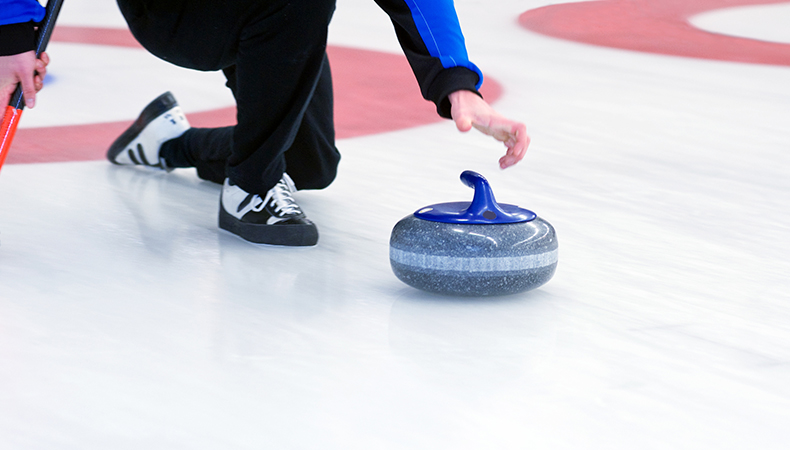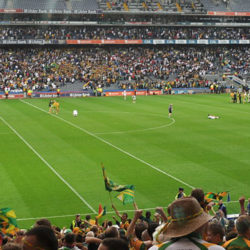
I regularly go 47 months in a row without thinking about curling even once, and then I spend a month fascinated by the sport. I don’t think I am alone in this. The Winter Olympics provides the only venue for me to watch curling (I think; I really haven’t looked), but when it is on, I am awed by the skill and strategy involved in throwing 42-pound stones 126 feet across a sheet of pebbled ice.
For those unfamiliar with the rules of the sport, the object is much like horseshoes – get as close to the target (called the “button”) as possible. Scoring stones have to be within 6 feet of the button (in an area called “the house”). Each team consists of 4 players who each throw 2 stones, alternating throws with the opposing team. While throwing, the player starts from a starting block (“the hack”) and has to release the stone before reaching a limit line (“the hogline”), sending the stone down the ice. Other players on the team can sweep (“sweep”) in front of the stone with brooms to clear debris and reduce friction on the ice, allowing the stone to speed up on its journey down past the other hogline to the house. The shooter may also spin the stone while releasing it, which will cause it to turn (or “curl”, hence the name of the sport) as it travels down the ice. Using this technique, stones can pass other stones and land behind them. At the end of a round (“an end”), the team with the stone closest to the button (“shot rock”) scores a point for all stones that are in the house and closer to the button than the closest stone thrown by the other team. Whoever scores in one end throws first in the next end, giving the opposing team the opportunity to throw last (an enviable position called “having the hammer”). If neither team has a stone in the house at the conclusion of the end, then whichever team had the hammer in that end will keep it for the next. (This was a quick rundown. I am sure you can find more comprehensive rules if you search.) The team with the most points at the end of 10 rounds wins.
It is also noteworthy that the game is played in succession; each team takes its next turn after seeing what the current state of the ice is. This makes this sport different from, say, ice hockey, where strategy relies on the other team’s play, but the action is simultaneous.
On February 15th, the US men played Italy in one of the highest-scoring games in Olympic history. (This sounds more impressive than it might really be; the sport has only been played in the Olympics since 1998.) In the 7th end, the US was trailing Italy by a score of 9-6 (after Italy picked up 3 points in the 6th end). Italy played a very conservative strategy, which makes sense with such a large lead and little time to close the gap. They kept the house clean, meaning that they would take out US stones in scoring position rather than try to score closer, knowing that it would be okay if the US scored one point in that end, giving Italy a 9-7 lead going into the 8th with the hammer. With the last stone, there was only one stone (from Italy) in the house, and it was in the 12’ ring (hence far from the button). It would be easy for the US to take their point with a straightforward throw to the button, a shot John Shuster (the athlete throwing the last stone, and the team captain, or “Skip”) must have practiced thousands of times before. Instead, Shuster threw a stone with more force (“take-out weight”) to hit the Italian stone and leave that end as a non-scoring one for either team. This led to two beneficial changes in the game. First, it would mean that the US would keep the hammer for the 8th end; even though they would not close the gap on their deficit with a score of 9-7, they would give themselves a chance to have an end with multiple points, and this would come closer to the end of the match. The other effect was that they would likely put themselves in position to have the hammer for the final end, as well. This is a product of the power of the hammer.
How important is the hammer? Through round robin play for the men’s Olympic curling, the team with the hammer scored in 90% of their ends. So having the hammer in 8 means that, in all likelihood, the US would also have the hammer for the 10th end, effectively “controlling their destiny.”
Strategically, this seems like a great way to go. This should be the end of the analysis, but knowing that many readers will not want to search for the results of this one match, I will share the outcome. I want to be clear, though, that analyzing the quality of a strategy only by how it turned out is not really analyzing strategy, but instead boils down to “good outcomes must have come from good strategy,” which is referred to as hindsight bias.
Anyway, back to the match. The US did indeed take the 8th end with 2 points, closing the gap to 9-8. This means that if they could hold Italy to 1 point in the 9th end (to make it 10-8), they would have hammer to take the match.
After a solid start to the end by the US, Italy ended up peeling off one of the US scoring stones to leave the US winning the end with one stone (9-9), giving Italy the hammer for the final end, which they took with one stone, winning the match 10-9.
The more you watch curling, the more strategy you will see develop. (Ever watch skeleton? The strategy there is to go fast.) This interplay between decision makers in a turn-taking game makes this sport riveting to watch.




Subscribe Now
Get each new post sent straight to your inbox